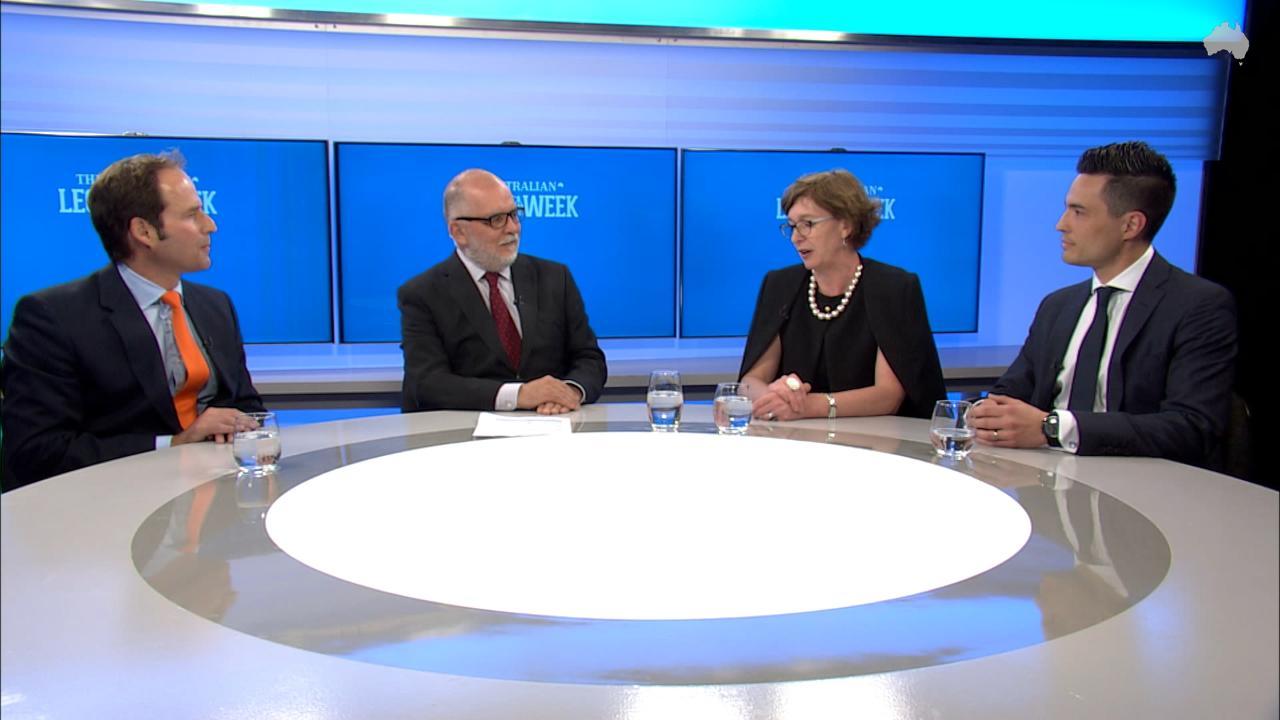Legal Week roundtable: Necessity the mother of reinvention
The forces that are disrupting the established order are also creating opportunities — but not for everyone.

The forces that are disrupting the established order in the legal services market are also creating opportunities — but not for everyone.
To seize the benefits from a crowded market, law firms are not only abandoning outdated ways of doing business, but in one case, the partnership structure itself is being questioned.
Consensus on the need for internal change is the clear message from today’s roundtable discussion with law firm leaders that is part of The Australian’s Legal Week initiative.
This initiative includes a series of special reports, videos and the publication last Friday of the latest edition of The Australian’s legal magazine, The Australian Legal Review, which is still available online.
Today’s roundtable discussion involved leaders from three firms: Jamie Ng from Ashurst, Anna Collyer from Allens and Adrian Tembel from Thomson Geer. This is an edited transcript.
The discussion, which was co-ordinated by legal affairs editor Chris Merritt, began when Adrian Tembel was asked how law firms had found themselves at the cutting edge of a wave of innovation. It follows last week’s roundtable with Sue Kench from King & Wood Mallesons, Danny Gilbert from Gilbert + Tobin and Stephen Purcell from Dibbs Barker.
ADRIAN TEMBEL: Well Chris can I jump in and kick it off with something a little provocative?
GDP in Australia is quite robust, 3 per cent plus for the last 12 months. Transactional regulatory complexity in Australia has probably never been higher.
I’m yet to meet an in-house lawyer who doesn’t say that she is frantically busy and under enormous pressure and the big four consulting firms, I’m talking about the former auditors, have all achieved double-digit growth in the last 12 months.
And yet in your column, less than a fortnight ago you published data that showed big law in Australia has been contracting for four years. So I throw that in and say why is it that there is such a structural contraction?
I’m not saying in the respective firms at this table but as a sector that data was based on deep sector data of large law firms both global and domestic in Australia. So it must have some degree of meaningfulness. Why is that occurring in the environment that I described?
That might kick off the answer as to why big law, as I’m going to call it, is beginning to change.
Now you’ve used the word innovation and I think that’s entirely appropriate. That gives an impression of technology and software and maybe almost an easy solution to some of the challenges we have to face. I’ll just use the word change which encompasses, obviously technology but a whole range of other reforms and restructuring that is going on in our sector to respond to that data, that frightening data that you published less than a fortnight ago.
CHRIS MERRITT: Well the pie is shrinking. Is that what we are talking about?
ANNA COLLYER: Another word apart from innovation that keeps getting thrown around is disruption and they are both starting to lose their meaning.
But our clients’ businesses are being impacted as well by things such as enormous change in technology that is creating so much data that is available, creating connectedness and really enabling, reducing barriers to entry, enabling new competitors.
So all of our clients are facing significant change in their markets and in the way they are performing and providing their services and so they’re looking to all of their service providers to support them and one of the big things that has happened in the legal profession is the significant “in-housing” of services.
So there are still legal services being provided but by a really different means as clients are looking to meet their needs in a different way.
TEMBEL: I agree with you completely. Legal services are growing in Australia. The outsourcing of legal services to big law has contracted for the last four years. So our relevance if we want to put ourselves in that category, has been questioned by the buyers of legal services. Why and what are we doing to address that?
COLLYER: Yeah and so the other thing that’s really relevant is not in-housing but also I think, the new entrants.
In the mining boom when all the international firms came down, that all seemed to make a lot of sense because we had a busier market than they were in, but what we see now is notwithstanding that contraction in the market, we are getting both international firms still coming down and sort of setting up boutiques and using lots of different structures as well as the sort of new law establishing itself and again finding different ways to provide services.
So those two things suggest people are seeing opportunities notwithstanding the contraction of the market and I think it’s about clients’ changing needs and finding different ways to address them.
JAMIE NG: When we look at innovation, we look at it as a firm-wide proposition but quite easily broken down maybe neatly into two separate areas.
So there’s the competition, risk element which is a lot of what we have been speaking about now but there is also the market risk side of it. What I mean by that is, on the competition side you had maybe that we want to introduce new law capability so that we can capture a margin that otherwise would disappear.
Or maybe we just don’t want to lose money or maybe the client is pushing us to deliver more for less. So there is all of that adoption going on in law firms at the moment.
On the market side of it I think that is where we can use new law capability and other types of innovation to drive new revenue streams. So it’s not all sort of declining.
Yes, it is super competitive and we will get to a point where we don’t enjoy the same level of revenue we may have out of traditional areas. But we can pick up new revenue streams by looking into new markets and adopting those capabilities as well.
MERRITT: So it’s a changed world, that’s what the bottom line is. It sounds like the market in which lawyers practise is just completely different.
TEMBEL: Our buyers are far more — no disrespect to previous generations — but our buyers, principally senior lawyers, are far more sophisticated and far more educated broadly about the legal process.
They understand where the value lies and where the value may not lie. They dismantle, they unbundle and that is provocative. And Jamie, that was very diplomatically put and I agree with everything you say.
You know, maybe you reduce margins, maybe some reduced revenues. The reality is and we need to be honest about it, is that prices in Australia — I’m talking about the sector as a whole — have been dropping.
So what does that say about the previous value proposition, before the increased sophistication of the buying process? Maybe we were just a little bit un-innovative, if there’s such a word.
But anyway modern demand, as we call it, is beginning to bring out the best of us and that’s when it becomes far more interesting, doesn’t it?
Because which directions do we all respectively choose? Where do we make our investments and do we match some of the big consulting firms? What can we learn?
What can we develop to perhaps not lose market share in the way that they certainly plan for us to lose market share? That’s just one example.
COLLYER: And I think it’s really interesting. Not so long ago law firms looked the same, like in their tiers.
So big-four law all looked like this and then mid tiers all looked like that but actually now we have to start making some choices about how we want to go, how we want to differentiate ourselves and what investments we want to make.
And so I do think it’s more interesting and exciting and I kind of see it as you know, there’s the threat, there’s always the opportunity as well.
So if you do find something that’s really going to meet clients’ needs and you are the one that develops that first then you can get an advantage in the current market.
So it’s not only the new entrants that are coming in that can find those opportunities.
I think it’s still the case that large law firms who have got great client relationships, who have got really smart people, you know have got an opportunity to disrupt themselves, to use another kind of cliche at the moment, but it’s true.
MERRITT: Is it pushing it to say the market is forcing big law particularly but also other law firms to reinvent themselves? Is that overstating things?
COLLYER: I think that’s the case. It is consistent with all of the other sectors. So we see all of our clients having to reinvent themselves. So it’s only natural that we would have to as well.
TEMBEL: I think it has been principally forced upon the sector, that is the need to change or the need to innovate but I don’t think the sector itself should feel negative about its inability to have responded earlier.
It is a sector that is deeply built around certain regulation and certain tradition which is quite legitimate.
But with deregulation and a more sophisticated buyer, our time has arrived and the moment has arrived for us to innovate, change, develop and use.
MERRITT: Strategic responses to this change could be the making of some firms and the reverse for those that make a wrong call.
TEMBEL: Yeah.
MERRITT: You agree?
COLLYER: Yeah, I think that’s right.
MERRITT: Which brings to the next question, what’s happening? How are you doing this? What is the detailed response to this changed nature of the market?
TEMBEL: Some legal consultants attempt to apply a general response to every different law firm just because they happen to do legal work. They don’t get the way law firms work and I don’t think they have ever been a partner and a leader in one.
They are all unique organisations. Yes, there’s been a uniform classification historically but the culture and the individuals involved vary quite significantly. So everyone needs a different solution.
I don’t know the ins and outs of Blake Dawson and Ashurst but I’m a big admirer of bold decisions to globalise and internationalise a very successful domestic practice.
That’s not relevant to us. In our organisation we are a high-growth, emerging domestic firm. We see wonderful opportunities to diversify our services and invest further in potentially allied services and to grow geographically.
Our revenue is only north of $130 million, so we are materially smaller than the two firms across the table, so we do see the ability to build scale and to diversify our earnings.
We are on the record of saying that we are deeply immersed in examining a transparent structure, a structure that is far more evidence-based as oppose to perhaps being personality or politically based, that has available efficient equity capital to make appropriate investments and has long-term capital growth incentives as oppose to short-term profit. How do we achieve that?
An incorporation and a potential raising of third party capital we think may suit us. We’re not there yet but it may suit us.
Now I would never say that that scenario or that strategy should be embraced by everyone around. I’m not saying that at all but for us where we are, with the opportunities that we see — and we may be wrong on our strategy — but if we are right, we know we need that turbo boost that comes from a more modern transparent and efficient capital structure.
MERRITT: If you’re not going to incorporate, and there are tax problems in incorporating, if you are going to remain a partnership, how do you respond? What do you do to show the client that you are right on the edge of innovation?
COLLYER: So one of the things that’s really important to us is the idea of a multidisciplinary team and this is something that we’ve actually been building over a number of years.
We have a team at the moment under our banner of A+ that comprises technologists and legal project managers and pricing experts. So a range of different experts who then work on an integrated basis with our lawyers who are expert obviously in the law, in order to deliver a kind of an integrated, seamless service to our clients and also to be able to innovate on how those services are provided.
Ten or 15 years ago that would be seen as a back office function whereas we regard this as a critical growing and mainstream part of our business.
Just to build on the point that Adrian’s making — not only are all law firms not the same, not all clients are the same. So one of the things that we feel is critical is developing those client conversations.
I don’t think there will be any of sort of one-size-fits-all offering in the current environment.
MERRITT: Jamie, inside Ashurst, what’s happening there?
NG: We have all of our new law capabilities sitting under Ashurst Advance. There is a culture element to it though to ensure that everybody else in the practice really adopts that new mentality.
So you know, we have been through a process of what we call “design jam”, so that the practices can really understand that new law capability and between them co-create ways in which service delivery can be enhanced within the firm. So that was the starting point and that’s naturally been a really great testing ground or test bed for co-creation attempts with our clients as well. So it definitely will be very customisable.
It won’t just be “oh look, here’s a product. You should use it”. It’s not like that. It’s fully customised and co-created with the clients.
MERRITT: It sounds like technology, IT, is becoming absolutely central to the practice of law. Am I right?
COLLYER: I think it will be. I think in terms of technology there are quite a few different ways in which it is impacting and will impact the practice of law.
There’s technology that can effectively replace what it is that lawyers have done in the past or currently do and sort of think about that as artificial intelligence.
So the kind of technology that we have been working with is predictive coding. When you have any enormous document review exercise as they all are now for litigation and regulatory matters, you can use your technology to, in quite a sophisticated way, streamline that review.
That’s been tested in the High Court in the UK and that’s a legitimate way of working out what documents need to be produced in a litigation.
Other kinds of really interesting artificial intelligence are, machine learning tools, so you can give a piece of software, a series of contracts — say a series of leases — and tell it that these are the three important clauses we need to find. And then you give it the next 100 and it can find them on its own.
The second bucket of technology that is really critical is around collaboration and how we work. So an example of that that we have been again working on is E-signatures on electronic documents.
And the third bucket I think is just things that make us do our work quicker.
One of the most important things I think is around culture and the ability to change and be able to take risks and figure out the way forward. Perhaps traditionally that has not been the skill set of a lawyer.
MERRITT: Jamie, what are the implications of all this use of technology? Is it going to put lawyers out of work or is it simply going to push them higher up the totem pole so that the grunt work, if you like, is benefiting from a lot of technology and the technical legal skills are given a lot more attention?
NG: I think technology is only upside for lawyers. Those tools are fantastic. They just make work so much more enjoyable because you’re not focused on muscle-related tasks or grunt work.
You are focused on the cerebral aspects. So I think what we are really looking for when we look to the future and who are the type of people we want to recruit, it really is a new type of human being.
You know, we have got skills and we have technical knowledge and so on. That’s important. It will be supplemented with skills in law like a legal technologist’s functions, IT and that sort of thing.
So there will be naturally, that need for expertise there but it’s almost like you know, going forward, it’s not that it recedes in importance but it’s kind of becoming overshadowed by the need for these more humanistic skills as well, like adaptability, like flexibility, like originality.
You know, focusing on those sorts of more cerebral things that computers can’t do. I always give an example that I might be able to use artificial intelligence to review 12,000 documents, but if I’m going to negotiate a sale and purchase agreement, you know the computer can’t stage a walkout to get a point.
So I think there will always still be a need for lawyers but, you know, the skill set, as has been really well pointed by my colleagues here, is going to change.



